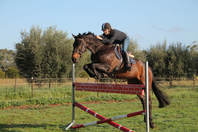
Lots of people like the idea of riding bitless but are not completely sure where to begin or if it’s worth the time and effort required – not to mention the extra expense of another piece of gear. However, the transition to bitless riding is not only relatively straight forward it is also a great way to enhance your horse’s training and can help develop calmness, improve self carriage and also fine tune jumping technique.
We use a bitless bridle on all of our own horses – not all of the time, but usually at least once per week. Any training they can do in a traditional bridle; they can also do in a bitless one. So, they will jump, cross country school, do working equitation obstacles, dressage and general fitness work in their bitless bridles.
We use a bitless bridle on all of our own horses – not all of the time, but usually at least once per week. Any training they can do in a traditional bridle; they can also do in a bitless one. So, they will jump, cross country school, do working equitation obstacles, dressage and general fitness work in their bitless bridles.
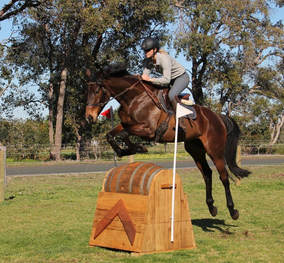
Bitless bridles are a great way of improving the horse’s jumping technique because the horse is unrestrained by the possibly aversive pressure of the bit. Even in the hands of very skilled riders, bits can apply quite extreme pressure. Horses’ mouths have as many nerve endings in them as ours and, because they are discriminatory grazers, their lips and tongues are extremely sensitive and dexterous. We have noticed that when horses are jumped regularly in bitless bridles their jumping technique improves, particularly in the way they move their necks over the fence. This is partly because the muscles at the base of the neck are linked to the muscles in the forearm and therefore allowing the horse more freedom in his neck can improve the technique of the front legs.
When two pressures are presented to the horse simultaneously only the most salient (or the ‘loudest’) will be responded to. This is called overshadowing. If a horse does not jump in self carriage and therefore the rider is applying strong pressure with the reins (both on the approach and in the air), this can overshadow the horse’s natural desire to avoid touching obstacles. We have found that when the horse is retrained to maintain a steady rhythm while jumping he is much less likely to touch his fences. If this behaviour can be maintained in a bitless bridle there will be even more improvement.
We try and maintain our horses as naturally as possible because we believe this is what is best for their welfare. This means trying to allow them to express as many of their hard-wired behaviours as possible. The bitless bridle doesn’t interfere with the horse’s natural mouthing behaviours, which means they are free to lick and chew. It’s difficult to know just how important these behaviours are to the horse but we do know that when tight nosebands are removed horses often move their mouths quite a bit as if to make up for lost time. Scientists call these movements post inhibitory rebound behaviours and their existence suggests that facial movements are a vital part of the horse’s ethogram (the blueprint for natural behaviour that all horse’s are born with). We never use overly tight nosebands on our own horses as we don’t believe it’s ethical and we adjust the bitless bridle in the same way as we would any other noseband – that is, you should easily be able to fit two fingers between the noseband and the front of the horse’s nose.
Training self carriage is one of the best things you can do for your horse. This means the horse will maintain a constant tempo and line without constantly being reminded. Unfortunately, lots of riders slip into the habit of nagging with their aids and, because of this, their horse’s basic responses are detrained. Fiddling with the reins to achieve flexion or outline will also detrain the basic responses and can make self carriage more difficult to achieve. If we look at the training principles of Equitation Science, it is easy to see that the horse’s head carriage is less of a priority than the speed and direction of his legs. Doing some of the horse’s basic training in a bitless bridle removes the rider’s desire to fiddle with the reins and can help address the losses of self carriage that are at the heart of tension under saddle and many problem behaviours.
Riding bitless gives you an interesting insight into your horse’s vision. Whether we like it or not, the bit will often change the way the horse carries his head and it is important to understand this, particularly while jumping and riding across uneven ground. Horses have quite a narrow field of vision (vertically) and the shape of their heads and the position of their eyes determines the best position of the head for clear, unimpeded vision. As an example, one of our horses likes to carry his head quite high on the approach to a fence and another carries his head quite low. Jumping bitless allows the horse to position his head in a manner which allows him the best vision possible.
We have noticed that many horses are calmer when ridden in a bitless bridle and we believe this is because the potential for really aversive pressure is absent. The bitless bridle can definitely assert aversive pressure but the variety that we use (which is basically a cavesson noseband with reins attached) is unlikely to be able to create pressure as strong as the pressure of a bit. Also, many horses have formed unpleasant associations with the bit because of poor training in their pasts. We often use the bitless bridle in the early stages of retraining these horses because it can be easier to maintain calmness.
In the next instalment we’ll show you how to transition to bitless riding… read here
When two pressures are presented to the horse simultaneously only the most salient (or the ‘loudest’) will be responded to. This is called overshadowing. If a horse does not jump in self carriage and therefore the rider is applying strong pressure with the reins (both on the approach and in the air), this can overshadow the horse’s natural desire to avoid touching obstacles. We have found that when the horse is retrained to maintain a steady rhythm while jumping he is much less likely to touch his fences. If this behaviour can be maintained in a bitless bridle there will be even more improvement.
We try and maintain our horses as naturally as possible because we believe this is what is best for their welfare. This means trying to allow them to express as many of their hard-wired behaviours as possible. The bitless bridle doesn’t interfere with the horse’s natural mouthing behaviours, which means they are free to lick and chew. It’s difficult to know just how important these behaviours are to the horse but we do know that when tight nosebands are removed horses often move their mouths quite a bit as if to make up for lost time. Scientists call these movements post inhibitory rebound behaviours and their existence suggests that facial movements are a vital part of the horse’s ethogram (the blueprint for natural behaviour that all horse’s are born with). We never use overly tight nosebands on our own horses as we don’t believe it’s ethical and we adjust the bitless bridle in the same way as we would any other noseband – that is, you should easily be able to fit two fingers between the noseband and the front of the horse’s nose.
Training self carriage is one of the best things you can do for your horse. This means the horse will maintain a constant tempo and line without constantly being reminded. Unfortunately, lots of riders slip into the habit of nagging with their aids and, because of this, their horse’s basic responses are detrained. Fiddling with the reins to achieve flexion or outline will also detrain the basic responses and can make self carriage more difficult to achieve. If we look at the training principles of Equitation Science, it is easy to see that the horse’s head carriage is less of a priority than the speed and direction of his legs. Doing some of the horse’s basic training in a bitless bridle removes the rider’s desire to fiddle with the reins and can help address the losses of self carriage that are at the heart of tension under saddle and many problem behaviours.
Riding bitless gives you an interesting insight into your horse’s vision. Whether we like it or not, the bit will often change the way the horse carries his head and it is important to understand this, particularly while jumping and riding across uneven ground. Horses have quite a narrow field of vision (vertically) and the shape of their heads and the position of their eyes determines the best position of the head for clear, unimpeded vision. As an example, one of our horses likes to carry his head quite high on the approach to a fence and another carries his head quite low. Jumping bitless allows the horse to position his head in a manner which allows him the best vision possible.
We have noticed that many horses are calmer when ridden in a bitless bridle and we believe this is because the potential for really aversive pressure is absent. The bitless bridle can definitely assert aversive pressure but the variety that we use (which is basically a cavesson noseband with reins attached) is unlikely to be able to create pressure as strong as the pressure of a bit. Also, many horses have formed unpleasant associations with the bit because of poor training in their pasts. We often use the bitless bridle in the early stages of retraining these horses because it can be easier to maintain calmness.
In the next instalment we’ll show you how to transition to bitless riding… read here

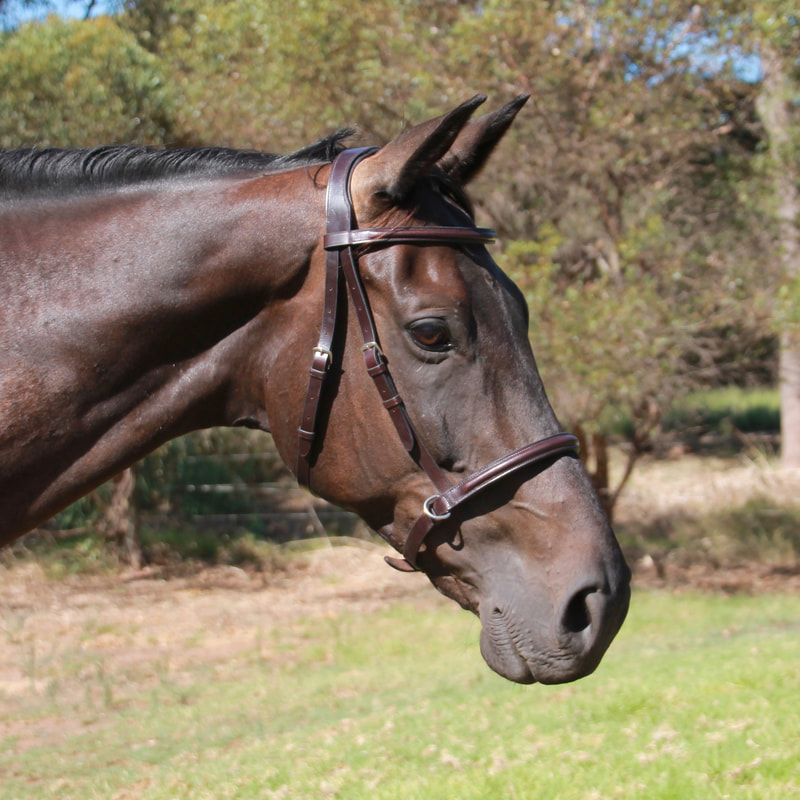
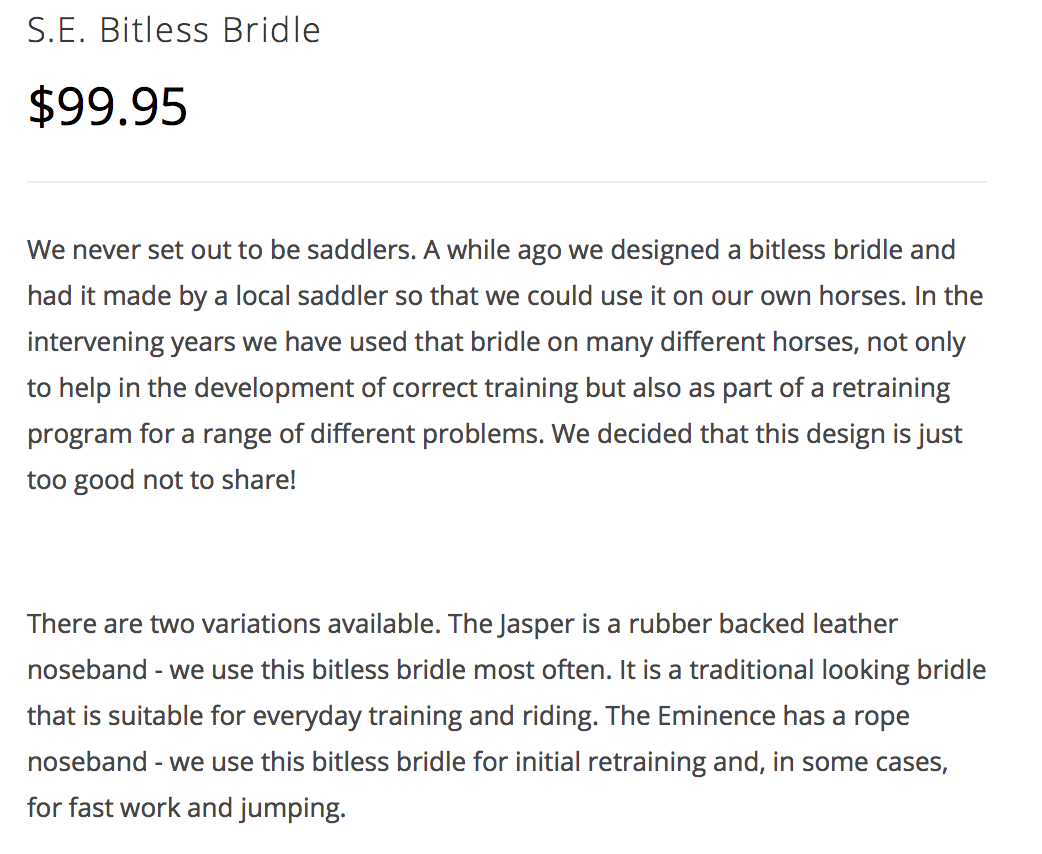
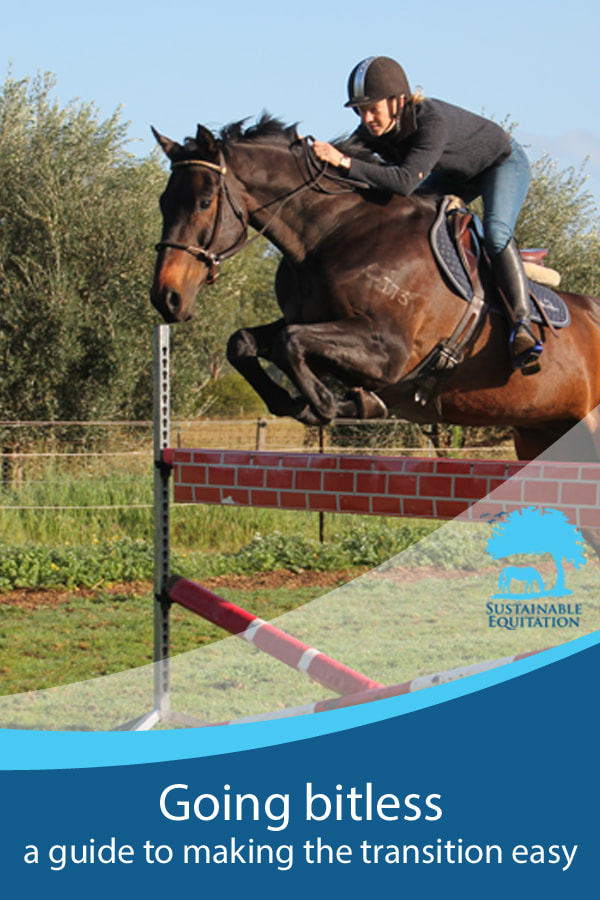
 RSS Feed
RSS Feed
